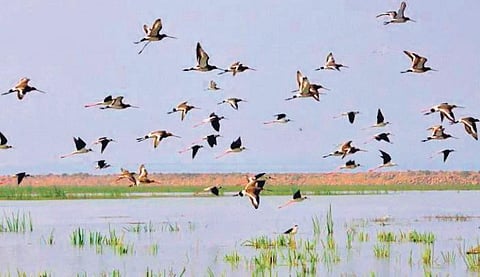

THRISSUR: The steep decline in the number of water birds in the Kole wetlands of Thrissur has sparked concern among bird watchers. Around 9,904 birds were spotted in the Asian Water Bird Census (AWC)-2023 held on Sunday, a significant drop from the 15,959 birds counted during the 2022 survey.
In fact, the spotting of water birds has been on a steady decline since 2018, when 33,499 birds were spotted. Ornithologists said the decline indicates a loss of habitat. They blamed unscientific constructions on Kole wetlands as one of the reasons for it.
Around 100 expert watchers gathered at the Thrissur-Ponnani Kole wetlands to take count of water birds in the area for the census on Sunday. Conducted since 1991, this was the 32nd AWC. The census is held annually to count and document the number of water birds.
Its data is used for various purposes, including raising awareness on the conservation of water birds, identifying Ramsar sites and monitoring the wetlands. For this AWC, the count was taken from 11 base camps in the wetlands, namely Adat, Alappad-Pullu, Enamavu, Palakkal, Thommana, Thottippal, Mulloor Kayal, Manakodi, Pullazhi, Uppungal and Maranchery. Ace birders Sethumadhavan C P, Shino Jacob, Manoj Karingamadathil, Lathish R Nath, Mini Anto and others led the teams in each region.
Rare birds also make appearance at wetlands
The survey was jointly organised by the forest department, Kerala Agricultural University and Kole Birders with the support of students from the College of Forestry, College of Climate Change and Environmental Science (CCCES), Sir Syed College, College of Veterinary and Animal Sciences, besides members of Cochin Natural History Society.
Ornithologist and CCCES dean P O Nameer, who coordinated the event, said, “The steady decline in the number of water birds is concerning. Unscientific construction done in Kole wetlands in the name of supporting farmers and dumping of waste in the area are major reasons for this.
A detailed study is needed to know the exact problem.” He said the drop in bird population was an indication of their losing habitat, which, in turn, was a reminder of the hydrological importance of the wetlands. Some rare birds were spotted too.
They included the migratory Amur Falcon, which visits the wetlands during these months, the Wood Sandpiper, which was spotted the most, and the Cattle Egret. Migratory birds like Glossy Ibis, Garganey, Whiskered Tern and Painted Storks were spotted in large numbers. The data from the survey has been uploaded to the eBird platform.